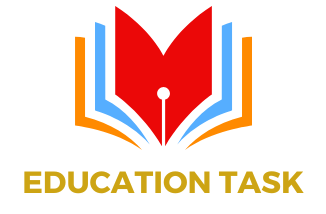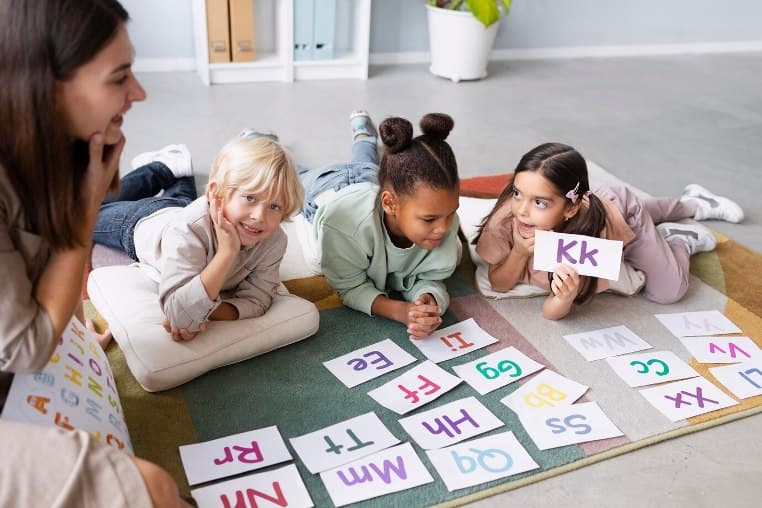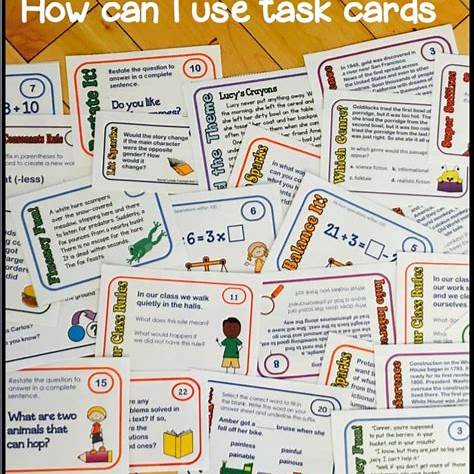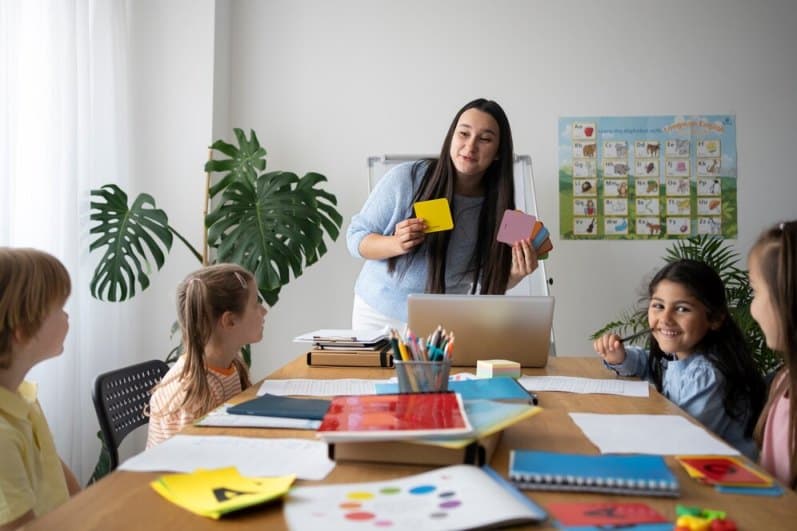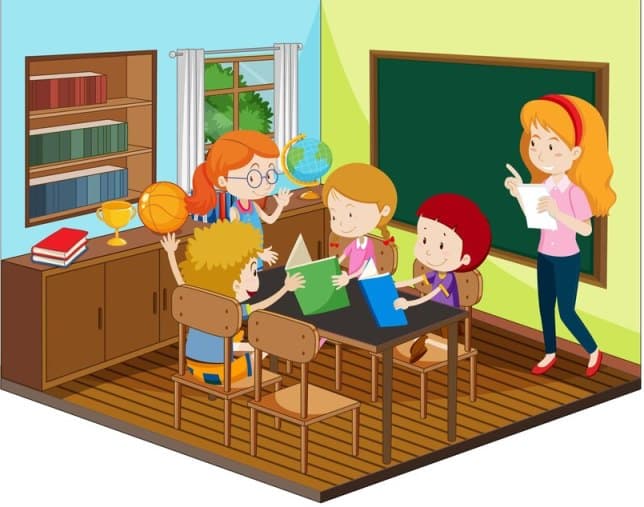In classrooms, task cards offer a dynamic way to promote active participation and cater to diverse learning styles. These small, versatile cards contain activities or questions that encourage students to think critically and collaborate with peers. They break down complex topics into manageable segments, making learning more accessible.
Teachers can use them to assess understanding, review content, or introduce new concepts. Task cards are flexible, allowing educators to adapt them to any subject or grade level. They are an effective way to foster independent learning and creativity. Discover how these cards can transform your classroom into an engaging learning environment.
What Are Task Cards?
Task cards are small cards with specific tasks or questions on them. They can cover any subject or topic. You can use them for math problems, spelling words, discussion prompts, or even science experiments.
Think of task cards as bite-sized pieces of a larger lesson. Instead of overwhelming students with a long worksheet, you give them one card at a time. This makes learning more manageable and less intimidating.
I remember using task cards during a history lesson. Each card had a different historical event. Students loved moving around the room, discussing each event with their peers. It turned a mundane history lesson into an interactive experience.
Benefits of Using Task Cards in the Classroom
Task cards are more than just an alternative to worksheets — they are a powerful instructional strategy that addresses a wide range of learning needs and teaching objectives.
When implemented effectively, task cards can significantly enhance both teaching efficiency and student outcomes. Below are the most impactful benefits of incorporating task cards in your classroom:
1. Increases Student Engagement and Motivation
Task cards provide a dynamic, interactive format that keeps students interested in learning. Unlike lengthy worksheets or lectures, task cards break down content into bite-sized, manageable chunks. This format appeals to students who struggle with attention or get overwhelmed by large tasks.
Students are more likely to actively participate when given the opportunity to move around the classroom, collaborate with peers, or work at their own pace. The variety of formats—multiple choice, short answer, matching, open-ended questions — also adds an element of novelty that sustains interest.
2. Supports Differentiated Instruction and Learning Styles
Every classroom contains a diverse group of learners, each with unique strengths, challenges, and learning preferences. Task cards make it easy to differentiate instruction without creating entirely separate lesson plans.
- For struggling learners, cards can be simplified or focus on foundational skills.
- For advanced students, enrichment task cards can provide higher-order thinking challenges or real-world applications.
- For kinesthetic learners, task cards can be incorporated into activities that involve movement, such as “Scoot” or gallery walks.
- For visual learners, task cards can include diagrams, charts, or images that support comprehension.
This level of adaptability allows teachers to provide personalized learning experiences that promote equity and inclusivity.
3. Encourages Student Autonomy and Independence
Task cards empower students to take ownership of their learning. When students work independently or in small groups, they make decisions about pacing, task order, and strategies to solve problems. This cultivates self-reliance and builds confidence.
Additionally, the modular nature of task cards enables students to self-monitor progress — they can see which cards they’ve completed, which need revisiting, and where they need clarification. This fosters a growth mindset and builds essential executive functioning skills like organization, planning, and self-assessment.
4. Enhances Classroom Management and Transitions
Task cards are a teacher’s secret weapon for maintaining smooth classroom flow. They can be used:
- As bell ringers to settle students quickly at the beginning of class
- As fillers during transition times or when a lesson finishes early
- As calming independent work for students who need a break
Because they require little prep during class time and are easy to implement, task cards are a low-disruption, high-impact solution to many classroom management challenges. They also reduce downtime and keep students productively engaged throughout the day.
5. Facilitates Formative Assessment and Data Collection
One of the most powerful uses of task cards is as a formative assessment tool.
Teachers can quickly observe how students respond to specific prompts or tasks, either informally during activities or by collecting responses afterward.
This real-time feedback helps educators:
- Identify learning gaps or misconceptions
- Adjust instruction immediately
- Group students according to skill level
- Plan for remediation or extension
Task cards also allow for ongoing assessment without test fatigue, offering more frequent check-ins on understanding without overwhelming students with formal assessments.
6. Fosters Collaboration and Social Learning
When used in pairs or small groups, task cards become a springboard for meaningful academic conversations. Students discuss strategies, compare answers, and explain their thinking to one another. This type of cooperative learning develops important skills such as:
- Communication
- Critical thinking
- Peer teaching
- Active listening
Collaborative task card activities encourage a positive classroom culture where students learn from each other and gain new perspectives on the material.
7. Builds Fluency and Reinforces Practice
Task cards are especially effective for building fluency in math facts, grammar rules, vocabulary, and other foundational skills. Their repetitive, hands-on format allows students to practice the same skill in different contexts, which strengthens retention and transfer of learning.
Using task cards regularly helps students internalize content and gain automaticity, especially in subjects where consistent practice is key to mastery.
8. Easy to Prepare, Store, and Reuse
From a practical standpoint, task cards are one of the most time-efficient tools a teacher can prepare. Once a set is created and laminated, it can be reused for years with little to no additional prep. They are also space-saving and easy to organize by subject, standard, or theme.
Digital task card options provide even more flexibility by allowing you to use them on tablets, smartboards, or learning management systems— perfect for hybrid or remote learning environments.
9. Versatile Across Grade Levels and Subjects
Whether you are teaching phonics in kindergarten, fractions in middle school, or literary analysis in high school, task cards may be customized to meet the requirements of your grade level.
Their versatility extends to all major subjects — math, ELA, science, social studies — and even to social-emotional learning, behavior management, and classroom routines.
Their universal appeal makes them a long-term investment for any educator seeking flexible, effective teaching tools.
How to Create Effective Task Cards
Creating task cards can be simple. Here are steps to ensure they are effective:
Define Learning Objectives
Before creating task cards, clarify the learning objectives you aim to achieve. Consider what skills or concepts students need to practice or master.
If you’re teaching 4th-grade math and the objective is “Students will be able to multiply two-digit numbers,” then each task card should present problems directly targeting that skill.
Choose an Appropriate Format
Task cards can take many forms depending on the subject matter and learning goals. Choose a format that aligns with both.
Common formats include:
- Questions: Multiple-choice or short answer
- Tasks: Specific problems or procedures
- Prompts: Open-ended or creative thinking challenges
- Scenarios: Real-world applications or case studies
Keep the Content Clear and Concise
Each task card should focus on a single idea or challenge. Avoid overwhelming students with too much text or multiple-step directions unless the objective specifically requires it.
Poor Example: List three causes of the American Revolution, explain why they were important, and describe how they still affect society today.
Improved Task Card: List two major causes of the American Revolution and briefly explain their importance. Use bold fonts for key terms, break up long sentences, and include bullet points or numbers where appropriate to enhance readability.
Incorporate Visuals and Design Elements
Visuals not only aid comprehension but also increase student engagement — especially for visual and English Language Learners.
Types of visuals to consider:
- Images or illustrations relevant to the topic
- Charts, graphs, or diagrams
- Icons or color-coding for organization or differentiation
Differentiate for Varied Learning Levels
Effective task cards should accommodate a range of abilities in your classroom. To do this:
- Include challenge questions for advanced learners
- Provide scaffolded support for struggling students (e.g., sentence starters, visual cues, vocabulary support)
- Offer tiered versions of the same card with increasing complexity
Review, Test, and Revise
After implementing task cards, gather feedback from students about what worked well and what didn’t. Use this information to revise and improve your task cards.
Strategies for Implementing Task Cards in the Classroom
Once you have your task cards ready, here are some effective strategies for implementation:
Station Rotation
Set up learning stations around the classroom, each with a different set of task cards. Divide students into groups and rotate them through the stations. This approach keeps students engaged and allows for collaborative learning.
Independent Practice
Assign task cards as independent practice. Students can work on them at their own pace, either during class time or as homework. This strategy encourages self-directed learning.
Incorporating task cards into independent work can also provide teachers with valuable insights into individual student progress.
Collaborative Learning
Pairing students to work on task cards fosters a collaborative environment where they can discuss and solve problems together. This strategy enhances critical thinking and communication skills.
Utilizing group role cards can further structure these activities, ensuring each student has a clear responsibility, thereby promoting accountability and effective teamwork.
Quick Assessment
Task cards can be employed for quick formative assessments to gauge student understanding of a topic. By reviewing student responses, teachers can identify areas that may require reteaching or additional support.
Gamification
Incorporating gamification into task card activities can significantly boost student engagement. For instance, organizing a scavenger hunt where students search for and complete task cards adds an element of fun and competition.
Exit Tickets
Use task cards as exit tickets at the end of a lesson. Pose a question or prompt related to the day’s lesson on the task card and have students respond before they leave the classroom. You can assess their comprehension of the subject matter by using this method.
Thematic Units
Design task cards around a particular theme or unit. This approach helps reinforce connections between concepts and provides a more integrated learning experience.
Conclusion
Task cards are practical tools for any classroom. They engage students actively. These cards promote collaboration and independent learning.
Teachers can address different learning styles easily. Task cards also make lessons more interactive and fun. Students benefit from varied activities and clear goals.
Implementing task cards can enhance understanding and retention. Start using task cards today for a more dynamic learning experience. Your students will appreciate the variety and challenge.
